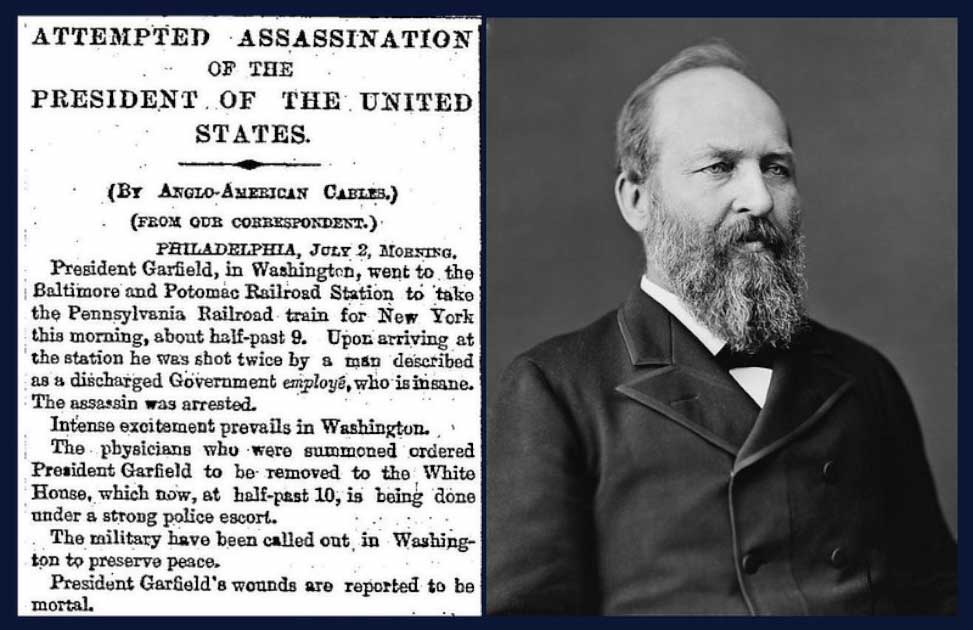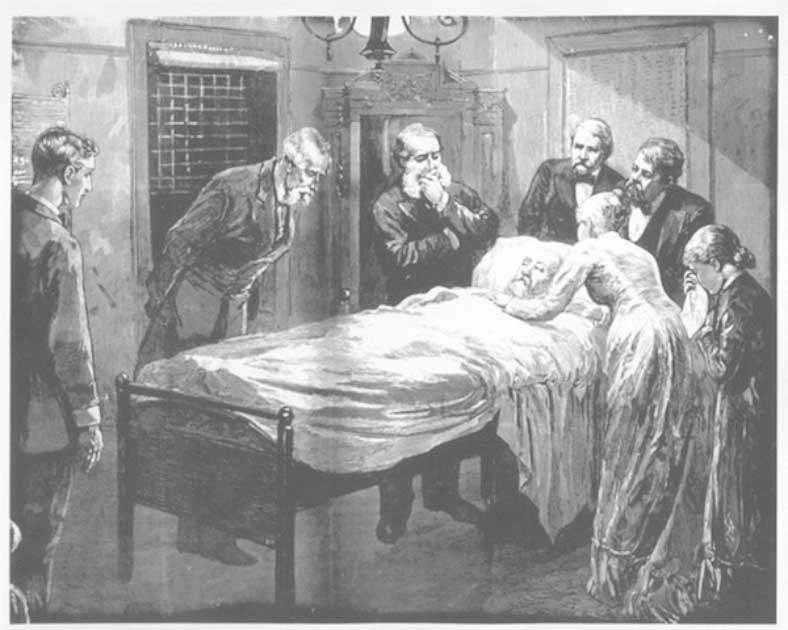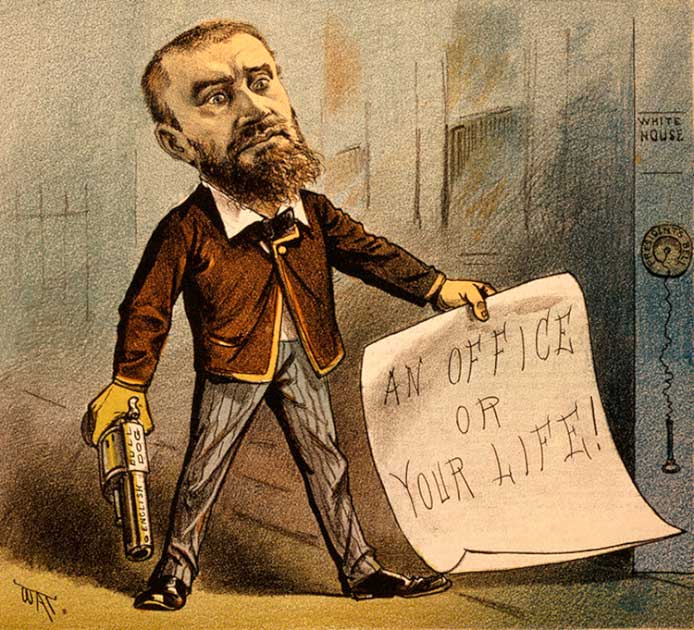James A. Garfield was the 20th president of the United States, and one of the less well known in history. Today he is chiefly remembered for one thing: on the 2nd of July, 1881, he was shot at the Washington DC’s Baltimore and Potomac Railroad Station at 9:30 am.
Although he survived the initial wound due to prompt medical attention it would ultimately prove fatal. He died on the 19th of September, 1881, due to infection.
Four Presidents of the United States have been assassinated. Abraham Lincoln was the first, and he along with John F. Kennedy have well known stories. William McKinley, the other President to have been killed, was shot by anarchists looking to overthrown anything that looked like order.
President Garfield, however, was killed by one of his own.
Early Life of James A. Garfield
James A. Garfield was born on the 19th of November, 1931. He was born in a log cabin and was brough up in northeastern Ohio. He graduated from Williams College and studied law to become an attorney.
In 1859, he became a Republican member of the Ohio State Senate and served till 1861. He was a major general in the Union Army and fought a number of battles. In 1862, he was elected to Congress, where he served for the next 18 years.
At the 1880 Republican National Convention, he was selected as the Presidential nominee by the delegates. He defeated Winfield Scott Hancock and became the President of the United States.
Nothing in his life suggests that he might have made any more enemies than was usual for an army man and a career politician. Perhaps, then, the answer lies with his assassin: Charles J. Guiteau.
Background of the Assassination
Guiteau, an American writer and lawyer, seems to have been troubled by delusions of grandeur. After failing in a number of ventures, he turned to the mire of Republican politics: here, he thought, he could finally achieve everything he felt was his due.
Ulysses S. Grant, the former President, was the front runner for the 1880 Republican presidential nomination. The Stalwart Faction, a faction of the Republican party, supported him, and Guiteau became a Grant and a Stalwart supporter.
He prepared a speech named “Grant against Hancock” in the expectation that his support would be rewarded when Grant won the nomination. However, this did not come to pass: Grant lost the nomination to James Garfield, and Guiteau, revealing himself as a true political chameleon, simply changed the speech to “Garfield against Hancock”.
- Medical Malpractice and the Mysterious Death of George Washington
- The Curse of Tippecanoe: Are some US Presidents Fated to Die in Office?
Even though Guiteau never delivered the revised speech, it was printed, and hundreds of copies were distributed. However, the speech was ineffective as Guiteau did not get the time to appropriately replace the references of Grant with Garfield. As a result, in the speech, he gave all the credits for accomplishments to Garfield that were initially ascribed to Grant.
Already the level of political hypocrisy is evident, and in Guiteau’s actions we can see a man who prized power for the sake of power but lacked political convictions, or even a clear idea of what he wanted to achieve beyond his own advancement. But Guiteau’s sense of entitlement and deluded self-importance stretched even further than this.
As Garfield’s campaign picked up pace, Guiteau started to believe that his speech was the reason behind the victory of James A. Garfield. And when Garfield won the Presidency, Guiteau believed this was down to him also.
He started expecting rewards and a diplomatic post for this “vital assistance” he had provided to Garfield. He waited for a long time but did not receive any reward, for obvious reasons: the President was barely aware of him.
His family members had started thinking of him to be insane, but he could not be swayed in his conviction. After he met with Garfield and his request for a political appointment was refused, he came to the conclusion that it had been his early support for Grant as a Stalwart which was now hurting his political career.
Garfield had chosen a Stalwart, Chester A. Arthur, as his running mate. If anything were to happen to Garfield, Arthur would become President and the Stalwart Republicans would again be in favor. Guiteau had nothing against Garfield, but in his mind he needed to restore the natural order of the Republican Party.
A plan started to form in his mind. He borrowed $15 from a relative and purchased a gun. He even sent a letter to the president. However, it was ignored. For weeks, he started stalking president Garfield. Throughout the month of June, he followed Garfield in Washington DC.
The Shooting of the President
On the 2nd of July, 1881, Washinton DC newspapers announced that President Garfield was due to leave for his summer vacation. Guiteau waited for the president to arrive at the Baltimore and Potomac Railroad Station, and Garfield duly arrived along with his two sons, Harry and James.
At the station, James G. Blaine, the Secretary of State, and Robert Todd Lincoln, the Secretary of War, waited to see him off. At the time the office of President was not seen as one that required extra security, and Garfield had no guards.

This was a grave error. As Garfield entered the waiting room of the station, he was shot from a point-blank range by Guiteau. Two bullets were fired by Guiteau. One hit the arms of the president, and the other hit his back. Garfield fell to the ground.
Guiteau put away his pistol and was about to leave in the cab that waited outside the station. However, as he left he collided with Patrick Kearney, a policeman who was entering the railway station after hearing the sound of the gun shot.
Guiteau was promptly arrested by Kearney. When he was asked about the reason for shooting president Garfield, he said that he was a Stalwart and wanted Arthur as the president. All four Presidential assassins thought that murdering the President would bring about political change, but none were perhaps so nakedly self-serving as Guiteau.
Death of the President
After Garfield fell to the ground, he was taken to an upstairs floor in the railway station. He was conscious but was in shock. The doctors were unable to find one of the bullets. Garfield was taken back to the White House, where his doctors declared that the President wouldn’t survive the night.
However, he remained alert and conscious. He showed good signs the next morning, and the doctors started hoping for his recovery. Regular bulletins were issued by the doctors of Garfield. His health condition fluctuated. He struggled in order to eat solid food and ate liquid foods most of the time.
Navy engineers set up an air cooler in order to provide relief to president Garfield in the heat of the summer. The doctors continued investigating the wound of Garfield with unsterilized equipment and even used their fingers to probe in the hope of finding the bullet. Even a metal detector was unable to locate the bullet.
The condition of Garfield worsened in the summer weather condition in Washington DC. He was taken to Elberon in New Jersey by train to a sea side mansion, Francklyn Cottage, in the hopes that the cooler air would aid his recovery.

But all efforts went in vain. He suffered from new infections and died on the 19th of September, 1881, at 10:35 pm. Many medical experts and historians believe that the President could have survived if the doctors had been more capable.
The body of Garfield was taken back to Washington, and then onward to Cleveland, Ohio, where his funeral was held on the 26th of September, 1881.
Murder for Political Advancement
Guiteau had hoped that the death of Garfield would restore the Stalwart faction of the Republicans, and apparently thought that with the Stalwarts in the ascendant his position in the Republican Party would improve, once his prison sentence was done. However, he seemed to have overlooked the fact that killing a sitting US President was frowned on.
Convicted for the murder of James A. Garfield on the 25th of January, 1882, he was given a death sentence.
Top Image: A Shooting in the Republican Party: why was President Garfield assassinated? Source: Internet Archive Book Images / Public Domain.
By Bipin Dimri
